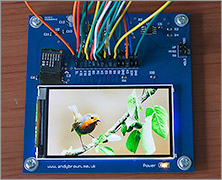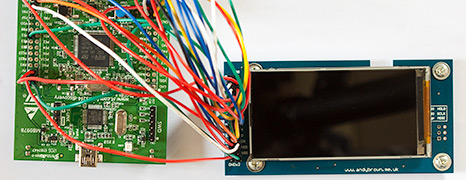It’s been about 3 years now since I last compiled up avr-gcc and avr-libc for Windows and it proved surprisingly popular with you so I’m now bringing you the latest, as of March 2015, versions of avr-gcc and avr-libc. I’ve also included avrdude 6.1 for completeness even...
avr-gcc 4.9.2 and avr-libc 1.8.1 compiled for Windows
posted by Andy
Arduino Uno R3 graphics accelerator shield uses no pins
posted by Andy
Hello and welcome to another in my series of unique hardware projects designed to bring you something useful that you’ve hopefully never seen before and at a price point that any hobbyist can afford. This project brings together the knowledge that I’ve gained over the last few years to bring you a graphics accelerator for the Arduino Uno R3 based on an ARM Cortex M0 core attached to a 640×360 LCD from the Sony U5 Vivaz cellphone. In previous articles you’ve seen how I’ve reverse engineered the Sony LCD and then used it in reflow oven and FPGA graphics accelerator projects. Introduction TFT LCD shields for the...
Reverse engineering the Sony Ericsson Vivaz high resolution 640 x 360 cellphone LCD
posted by Andy
Welcome to another in my series of cellphone LCD reverse-engineering articles. In this article I’m going to present everything you need to hook up the high-resolution 640×360 LCD from the Sony Ericsson U5 Vivaz to your project. About the phone and LCD The Sony Ericsson U5 Vivaz LCD...
Reverse engineering the LG KF700 480 x 240 widescreen cellphone LCD
posted by Andy
Hello and welcome to my first published non-Nokia cellphone LCD reverse-engineering effort. All my articles in this series focus on bringing you all of the details that you would need in order to connect a low-cost cellphone LCD to an MCU for use in your own projects. This one is no different. I will explain the pinout and the signals. I will tell you about the connector and where you can buy it and I will tell you about the controller IC and of course I will give away the complete source code driver for that controller. Let’s get started. The LG KF700 The KF700 was released in 2008 and is now a discontinued model. It featured a 3.0...
A generic optimised 16-bit LCD adaptor for the Arduino
posted by Andy
There are many TFT modules available on the market that are designed to connect directly to an MCU to provide a full colour graphical display, just search ebay for “tft module” to see what I mean. Unfortunately for Arduino users the majority of these modules expose a 16-bit...
Reverse engineering the Nokia E73 QVGA LCD
posted by Andy
Readers with a keen memory will no doubt recall that I said that the N93 would probably be the last of the Nokia QVGA LCDs that I attempt to reverse engineer. However probably is not definitely and one day whilst browsing ebay my finger slipped and next thing I knew I’d got myself an...
Arduino Mega 512K SRAM in shield format
posted by Andy
Some time ago now I presented the design, development board and software driver for an add-on to the Arduino Mega that gave it access to 448Kb of additional SRAM arranged in 8 banks of 56Kb. My design was realised by a compact add-on board that plugged into the relevant block of pins on the...
Reverse engineering the Nokia N93 QVGA LCD
posted by Andy
Welcome to what will probably be the last in the series of articles in which I reverse engineer one of the Nokia QVGA cellphone displays from the pre-smartphone era. I think that by now I’ve covered every possible aspect of these incredibly cost effective little displays and hopefully...







